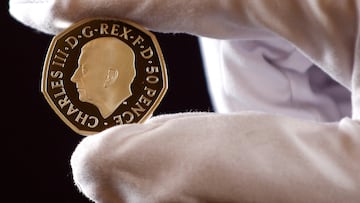What the first coins of Charles III are like revealed
Sculptor Martin Jennings studied several photographs of the new monarch to make the portrait. Charles III has congratulated the artist on the design.

The Royal British Mint unveiled on Friday the official effigy of King Charles III that will appear on coins after the death of Queen Elizabeth II. The portrait of the king will begin to be seen on coins in the coming months, when the 50 pence coins with the effigy of the British monarch will gradually begin to enter circulation, as detailed by the Royal Mint.
This new design, made by the sculptor Martin Jennings, shows Charles III facing to the left, contrary to how his mother did on coins, thus following the tradition imposed by Charles II in which each monarch looks in the opposite direction to his predecessor.
Britain's Royal Mint unveiled the first British coins to feature the image of King Charles. The new image will appear on 50 pence coins, which will begin circulating in the coming months, and also on a commemorative £5 coin https://t.co/3uacGguYUM pic.twitter.com/wSPzv1bRHg
— Reuters (@Reuters) September 30, 2022
On the coins, Charles III appears without a crown and is surrounded by a Latin inscription that translates as “King Charles III, by the Grace of God, Defender of the Faith”. The monarch has given his personal approval to the portrait and has informed the sculptor, as reported by the Royal British Mint in a statement.
The artist studied the photos of Charles III
To make the portrait of Charles III, the artist studied various photos of the new monarch. “You collect as many photographic images of your subject as you can to present just one side of somebody’s head, you have to understand how the head works in the round, so you examine all of these old photographs then settle on just one or two that give you the optimal impression of the side of the head that you are modeling,” says Jennings.
“The (original) piece is modelled in plaster larger than the size of the coin, so about the size of a dinner plate. I work by hand using tiny, tiny millimetres of material to model it. And eventually, once it is complete and cast in plaster, my original design can be digitally reduced so that the impression is the right size for a coin,” explains the artist.
Related stories
“It is the smallest work I have created, but it is humbling to know it will be seen and held by people around the world for centuries to come.”

“I was delighted to hear that The King likes the image. He was very interested in it and responded very positively to it. It has been very gratifying to be involved in this important process,” declared the sculptor. According to the agency, Jennings has been making public sculptures in the UK for many years. In particular, his works of great writers and poets stand out, such as John Betjeman in St Pancras Station, Philip Larkin in Hull, Charles Dickens in Portsmouth and George Orwell outside the BBC buildings.

